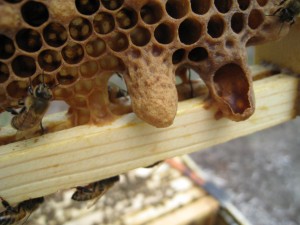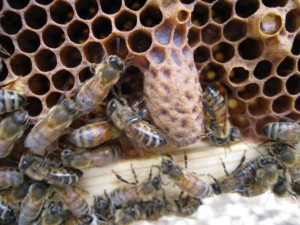The Honey Bee During Winter
Per my previous post, Ann Harmon of Flint Hill, Virginia, came down the the November East Richmond Beekeeper’s Association to talk to us about how the Honey Bee reacts to Winter. If you think about it, the Winter months are a time when the Bee really sets itself apart from many of the other insect of the world. Presumably, the Winter months are the one of the reasons that we get a great honey crop. The bees work all Spring, Summer and Fall, storing honey for the months when nothing is blooming (usually Winter, but really dry months are another good time to use your stores when you’re a bee!)
When the days start getting shorter and the temperature drops, the bees begin to stay home more. All of the nectar-producing blooms are on the way out, so the drive to go out at dawn and forage to dusk wanes. As you might imagine, when you change from a job that has you in 4th gear, most of the day, to one where your primary job is keeping warm and producing a bit of heat yourself, the stress on the old body lessens dramatically. In addition, when you’re not out presenting a tasty little meal to some wayward bird or hornet, your life span also increases. For this reason, bees live for 3,4,5 and (very rarely) 6 months during the Winter months (as opposed to 2 months during the nectar months!)
Obviously, with fewer bees dying off, the drive to lay a bunch of eggs decreases dramatically. Not only are you in a situation where resources are thin, but you need a temperature of 92 degrees for eggs and larva to grow ( and it becomes really hard to keep a large brood next warm when it is 10 degrees F). The goal of the hive is to keep enough bees to keep the hive warm, but not so much that all of the stored honey is used up before the Maples and Hollies bloom in Spring. The decreasing day length and cooler temperatures begin to affect the Queen in October. By November, egg laying should be virtually stopped.
The bees form the cluster and hang on for the ride. As we all know, the days begin to lengthen around December 21 and this is the sign to the queen to start ramping up her egg laying. For the first couple of weeks, the rate barely creeps up (but it definitely should not be decreasing anymore at this point.)
Once the main cluster reaches 57 degrees F (or thereabouts), the bees form he cluster. They slowly begin to gravitate to one another, shaking their thoraxes violently to create heat (the thorax is where most of the bee muscle is, so this is effectively like doing ‘jumping jacks’ to increase their core temperature and give off some heat into the cluster. As more and more bees come together, a ball forms. The further you get from the center, the colder the bees become. By the time you get to the edge of the cluster, most of these bees are barely able to do much ‘shaking’. They begin to work their way back towards the middle of the cluster, taking in the heat of their warmer sisters, warming their bodies up to begin the cycle again, center-to-edge, edge-to-center. (And interesting side note about the ‘cluster’ is a term known as ‘balling’. Here, the bees form a small ball around a predator (like a hornet) and also begin to generate heat. They can actually cook the invader with this action and it is a defense mechanism used sometimes in non-Winter months.)
As mentioned before, the cluster maintains a 90+ degree temperature in the center, when raising brood. When no brood is present, the temperature can drop to the low- to mid-80’s.
To close this out, Ann Harmon mentioned a couple of management techniques that she has learned over the last few decades. One involves shims for ventilation. She keeps her screened bottom boards open during the Winter and create a good gap at the top to create an air flow, providing a mechanism to move the damp air out of the hive. As I have seen where scientists demonstrated where a hive could be kept at minus 30 degrees for several months without perishing, this practice does not surprise me. But, I think this kind of practice assumes two very important things. One, the bees have plenty to eat. They are going to need do so a fair amount of work to keep the hive warm. Second, there are periods of ‘warm’ (40 degrees plus) during the Winter that allow them to move over to new honey and/or move honey from outside frames to the cells nearest the brood.
The second practice involved Mouse guards and it was not one that I recall hearing before. She takes half-inch hardware cloth and cuts it to be a bit longer and a bit deeper then the entrance to here hive. She then staples this across the entrance, allowing the bees to go but keeping the mice out. She is both North and West of me (closer to DC), but she strives to have these on by early October (according to Ann, the Mama mouse is out looking for a nesting spot at this time of year.) She uses no other entrance reducers for her hives.
That sums up the points that I noted from the talk. I have recorded them here for prosperity more so then for any other reason. I will try many of the tactics above and also try other methods that fly in the face of Ann’s thoughts. But, it’s always good to hear the experiences of a long time beekeeper and take note of them as you cut your own path in the beekeeping world!



